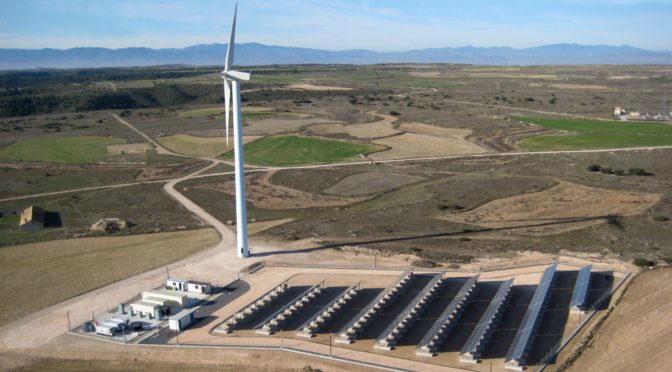Siemens Gamesa Renewable Energy today presented its results. Regarding fiscal year 2017(1), revenue increased by 5% to €10,964 million, while underlying EBIT was €774 million (-18%) with an EBIT margin of 7%.
Between April and September, revenues fell 12.3% while underlying EBIT came to €192 million(2) (-63.4%) with an EBIT margin of 3.8%. These results were impacted by specific onshore market conditions, including the temporary suspension of the Indian market, and impairments relating to accounting adjustments to inventories in the US and South Africa. Excluding these impacts, revenues fell just 2% with an EBIT margin of 7.3%2. Excluding also currency effects, revenues
were flat.
In India the government is planning 3 GW in central auctions up to next March, and the market is
expected to fully recover in 2019.
“Our financial performance is still not at the level we’re all aiming for. But it’s clear that we are
making positive progress as we carry out our plan to make this company an industry leader. Our
integration efforts are proceeding ahead of schedule, and I’m confident that the decisions we’re
making will allow us to better respond to changing market conditions, and to better serve our
customers and other stakeholders,” said Markus Tacke, CEO of Siemens Gamesa.
Restructuring programme
In the context of the ongoing integration of legacy structures, the company has announced a
restructuring plan affecting a maximum of 6,000 employees(3) located in 24 countries (700 already
announced).
Discussions with employee representatives will start immediately, in accordance with applicable rules and regulations in each country. Information on the final agreements will be communicated in due course, once negotiations are completed.
This plan, which will be implemented in the coming months, is a necessary step to strengthen the group and consolidate its position as a market leader.
The previously announced synergy target of €230 million is confirmed as a minimum and the company expects to achieve this target in the third year, 12 months ahead of schedule.
Commercial activity and profitability
Commercial activity intensified in the fourth quarter, both onshore and offshore, resulting in a
significant increase in order intake amounting to 3 GW (+40%). This volume reflects the improvement of Siemens Gamesa’s competitive position with the best quarterly onshore order
intake since the beginning of 2015 which reached 2.2 GW.
Between April and September, revenue from the sale of wind turbines decreased by 15% to €4.4 billion, impacted by onshore markets that are facing challenging conditions, mainly India and
the UK, as well as pricing pressure.
The company registered strong performance in the offshore business with an increase of 16% in revenues. Siemens Gamesa continues to lead the world offshore segment having installed 11 GW, more than 65% of the global offshore fleet.
Sales in services rose 9% to €621 million with an underlying margin of 17.4% and maintenance contracts continue to grow to cover 55,000 MW around the world, an increase of 12.4%.
In this specific market context, Siemens Gamesa obtained €118 million of underlying net profit(2) between April and September. Excluding the impact of the inventory impairment, underlying net income was €206 million.
The company continues to strengthen its balance sheet and ended the quarter with a net cash position of € 377 million.
Continued progress on the integration
Work on integration has underlined the company’s high potential derived from larger scale and a global reach, reflected by a presence in more than 90 countries, installed turbine capacity of 83 GW and an order book valued at €21 billion.
The company is on track to achieve more than 90% of the integration goals implemented and creating value from year three.
In this sense, Siemens Gamesa has achieved a number of important advances in the second half, including the integration of Adwen in the overall offshore business of the group. In addition, the company has decided to have one technology per business segment by 2020. It will streamline its onshore product portfolio, reducing the range by approximately 65%, and will implement a single-platform strategy in offshore. The new products will be announced at the upcoming Wind Europe conference taking place in Amsterdam in late November.
Siemens Gamesa maintains its highly positive outlook for the medium and longer term
The company has also announced its outlook for the 2018 financial year: revenues of €9,000-9,600 million and underlying EBIT margin of 7-8%. These projections incorporate the impact of the reduction in the onshore prices and expected synergies.
The transition in energy markets opens the doors to an enormous potential in the wind market over the longer term. Wind energy is expected to increase its weighting in the global energy generation mix by four in 2040, increasing from 4% now to 17%, according to independent projections.
The company will present a new Strategic Plan next February 2018 in the context of its Capital Markets Day. The company will give details of financial targets, dividend policy and management incentive scheme.
Siemens Gamesa key figures April – September 2017(4) (vs. April – September 2016)
Figures in euros:
| • | Revenues: 5,022 million (-12.3%) |
| • | Revenues in MWe: 3,599 (-26%) |
| • | Underlying EBIT(2): 192 million (-63%) |
| • | Underlying EBIT margin(2): 3.8% |
| • | Underlying net profit(2): 118 million |
| • | Net financial cash: 377 million |
Footnotes:
(1) LTM pro forma, non-audited, is calculated adding revenues and EBIT reported by Siemens AG for Siemens Wind Power, those reported by Gamesa and 100% of those reported by Adwen. Pro forma profitability includes standalone, normalization and scope adjustments for Siemens Wind Power.
(2) Underlying EBIT pre PPA excludes 103 mn € in integration and restructuring charges and 235 mn € of PPA amortization of intangibles fair value.
(3) Restructuring plan based on figures as of 30th September 2017.
(4) All financial information and KPIs are non-audited. All historic information is pro-forma.


